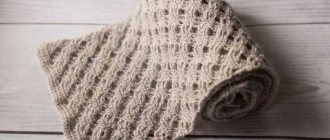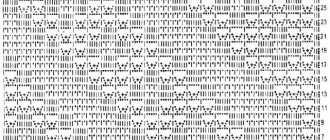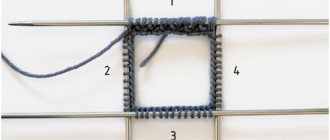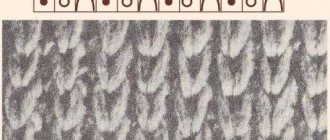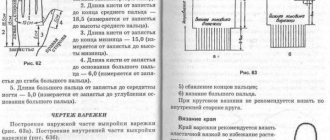How to tie a stole around the neck and head in different ways
Wide stoles can even be turned into a headdress and become a very functional product. If you manage to knit this option, then look at how to tie a stole beautifully on your head. You can simply throw it over your head and wrap it around your neck.
A wide knitted stole with knitting needles will be an excellent headdress, but can also replace the absence of a hood.
You can also tie a stole around your neck in different ways. By learning how to tie a stole beautifully around your neck, you will look stylish and fashionable and look different every time.
Narrow and thin ones can be tied in a bow or knot, and wide ones can cover the shoulders.
The stole can be hung around the neck in three ways: the ends can be made to hang freely, one end can be thrown over the shoulder and the other straightened, in the last option you can simply tie up the ends.
Knowing how to beautifully tie a stole on a coat, you can create a bright and unique look. A triangular stole will look beautiful if the central part is placed in front.
A rectangular stole can be tied around the neck, and if it is very wide, then one edge can completely cover the front of the coat.
How to knit an openwork stole with knitting needles: diagram and description
If you knit an openwork stole with knitting needles from mohair yarn, it will become light, but will not lose its warm properties. In fact, you can knit a stole in any pattern, because it is a rectangle. The size of the stole can reach up to 1 meter in width and 2.5 in length.
Necessary materials
- Yarn Yarn Art Silk Wool - 4 skeins.
- Knitting needles No. 3.5
Knitting pattern for an openwork stole with knitting needles in a leaves pattern
Before knitting, knit a sample from your yarn to calculate the correct number of stitches in the cast-on. The pattern report consists of 14 loops + 2 symmetry loops + 2 edge loops. About 20 reports can be used in length.
We cast on the knitting needles 284 loops (20 reports + 2 symmetry loops + 2 edge loops)
Empty cells are necessary in the pattern in order to preserve the pattern; you can simply skip them when knitting. Knit 24 rows and then start knitting the pattern from the 5th row. Thus, it turns out that the pattern report is from rows 5 to 24.
To make the stole wider, you need to add the number of loops in multiples of 14.
Beautiful stole “Lacy diamonds”
This openwork stole is knitted in a straight line, then a jagged border is knitted in the round with knitting needles.
Dimensions: 23″ by 60″
- mixed yarn: linen 42%, cotton 41%, lurex 9%, polyamide 8%, (50g per 225m) – 200g;
- circular knitting needles No. 3.75.
Description
We cast on with knitting needles 71 sts. and knit a row of purls from the inside out. loops In it we evenly decrease 2p. We begin to knit openwork diamonds, repeating rapport 33 times. In the last r. decrease 1 p. and close off all the remaining loops - 70 pieces.
By persons side we raise with knitting needles along the cast-on edge 71p. and drag the loops to the end of the needle, so that the first raised stitch is on the left needle. Next we dial an additional 13p. and knit from the 1st to the 33rd r. jagged edge (see diagrams). Then we repeat from the 3rd to the 22nd r. 6 more times. Along the long edge we raise 200 stitches, lifting 1 stitch at a time. in every even r. We repeat from the 3rd to the 22nd r. 20 times. Then we raise 70p. along the edge with closed stitches. Repeat from the 3rd to the 22nd row. 7 more times. Then we raise 200p along the second long edge. and repeat from the 3rd to the 22nd r. 20 times. Close the loops and stitch the cast-on edge with the edge of the closed loops.
Mohair stole: pattern and description of knitting an openwork accessory
To get a quality mohair item, the yarn should contain about 60-70% natural fiber. It will be very warm, durable and wearable. In order to get a thin tippet, take knitting needles in a pair or three sizes thicker.
Tip: wash the finished mohair stole in water at a temperature of 30 degrees, and dry it on a towel in an extended position.
A beautiful stole is knitted with the Openwork stripes pattern made from Kid mohair yarn (70% kid mohair, 30% polyamide, 25g/250m)
Legend:
- Face - facial
- Wrong - purl
- 2vm.l. to the right - 2 loops together with the front one tilted to the right behind the front wall
- 2vm.l.left – 2 loops together knit with a tilt to the left – broach
Knitting pattern for a mohair stole
The diagram shows the front rows, and we knit the purl rows according to the pattern, the yarn overs are purled.
The pattern report in height is 36 rows.
It is necessary to cast on the number of loops, a multiple of 13 + 1 symmetry + 2 edge
Using knitting needles No. 3, cast on the required number of stitches.
1st row: chrome, * 2 purl, yarn over, 2 inl.l. left, knit 8, 1 purl *, repeat **, purl, chrome.
2nd row: like all even ones, we further knit according to the pattern
Row 3: chrome, *P2, yarn over, k1, 2kL left, k7, P1*, repeat **, purl, chrome.
Row 5: chrome, *P2, yarn over, knit 2, knit 2 left, knit 6, P1*, repeat**, purl, chrome.
Row 7: chrome, *P2, yarn over, knit 3, knit 2 left, knit 5, purl 1*, repeat**, purl, chrome.
Row 9: chrome, *P2, yarn over, knit 4, knit 2 left, knit 4, purl 1*, repeat**, purl, chrome.
Row 11: chrome, *P2, yarn over, knit 5, knit 2 left, knit 3, purl 1*, repeat**, purl, chrome.
Row 13: chrome, *P2, yarn over, knit 6, knit 2 to the left, k2, P1*, repeat**, purl, chrome.
Row 15: chrome, * 2 purl, yo, k7, 2 vm.l. left, 1 knit, 1 purl *, repeat **, purl, chrome.
Row 17: chrome, *P2, yo, k8, 2vm.l.left, 1P*, repeat**, purl, chrome.
Row 19: chrome, * 2 purl, knit 8, 2 r.l. to the right, yarn over, 1 purl*, repeat**, purl, chrome.
21 row: chrome, * 2 purl, 7 knits, 2 knit, knit, yo, 1 purl *, repeat **, purl, chrome.
Row 23: chrome, *P2, knit 6, knit 2, knit 2, yarn over, purl 1*, repeat**, purl, chrome.
Row 25: chrome, *P2, knit 5, knit 2, knit 3, yarn over, purl 1*, repeat**, purl, chrome.
Row 27: chrome, *P2, knit 4, knit 2, knit 4, yarn over, purl 1*, repeat**, purl, chrome.
Row 29: chrome, *p2, knit 3, knit 2, knit 5, yarn over, purl 1*, repeat**, purl, chrome.
Row 31: chrome, *P2, knit 2, knit 2, knit 6, yarn over, purl 1*, repeat**, purl, chrome.
Row 33: chrome, *P2, k1, k2, knit 7, yarn over, purl 1*, repeat**, purl, chrome.
Row 35: chrome, * 2 purl, 2 knit to the right, k8, yarn over, 1 purl *, repeat **, purl, chrome.
Then repeat 36 rows as needed.
Stole made of medallions
Dimensions: 38cm by 188cm
- mixed yarn (100g per 320m) – 5-g;
- set of double needles No. 3.75;
- markers.
Density: face. satin stitch 28p. for 40 rub. equal to 10 cm by 10 cm.
Medallions (16 pieces): cast on 8 stitches, distribute evenly onto 4 stocking needles. Place a marker and make sure that the knitting does not twist.
Description
Start of the diagram
1st circular row: knit according to the pattern, repeating rapport 4p. Total 16p. We continue to work according to the scheme until 41 rubles. In total we have 144p. Please note the note, starting from 37 rubles.
First corner
Performed by forward/reverse knitting.
1r. (faces): closed trace 18p., remove the marker, 1p. leave it on the right knitting needle. *Decrease sts with a slant to the left: remove 1 st. as persons on the right sp., remove 1 p. as persons on the right sp., thread the left sp. in two removed stitches from left to right for the upper segments of these 2 stitches. and knit both stitches in 1l. for the bottom slice, 1l., 2p. in 1l., 1n., 1l., 1n.* – from * to * repeat twice, decrease p. with a slant to the left, 1l., 2p. in 1l., 1l. Rotate the canvas. We have 17p.
3p.: 1l., * remove 1p., next 2p. we knit and throw the removed stitch on the knitted ones, 1n., 3l., 1n.* - from * to * repeat twice, remove 1st., next. 2p. knit and throw the removed stitch onto the knitted stitches, 1l. We have 15 p.;
4p.: 2p. in 1i., 11i., 2p. in 1i. We have 13 p.;
5p.: 1l., decrease 1p. with a tilt to the left, 1l., 2p. in 1l., 1n., 1l., 1n., decrease 1p. with a tilt to the left, 1l., 2p. in 1l., 1l. Total 11p.;
7p.: 1l., remove 1p. as persons, next 2p. we knit and throw the removed stitch on the knitted ones, 1n., 3l., 1n., remove 1st. as persons, next 2p. knit and throw the removed one onto the knitted ones, 1l. Total 8 p.;
8p.: 2p. in 1i., 5i., 2p. in 1i. Total 7 p.;
9p.: 1l., decrease 1p. with a tilt to the left, 1l., 2p. in 1l., 1l. Total 5 p.;
11p.: 1l., remove 1p., next. 2p. knit, throw the removed stitch onto the knitted ones, 1l. Only 3 p.;
We break the thread and secure the end.
Second corner
We attach the thread to the remaining 107 stitches.
This is interesting: HIV styling according to Sanpin 2021 2019
1r. (persons): close 17 p., remove marker, 1 p. leave on the right sp., * decrease with a tilt to the left: remove 1 p. as persons on the right sp., remove 1 p. as persons on the right sp., thread the left sp. in two removed stitches from left to right for the upper segments of these 2 stitches, we knit them 1L. for the lower slices, 1l., 2p. in 1l., 1n., 1l., 1n.* – from * to * repeat twice, decrease 1p. with a tilt to the left, 1l., 2p. in 1l., 1l. U-turn. We have 17 p.;
We knit forward/reverse knitting on these 17 stitches, repeating from 2 stitches. 12 rub. first corner. We break the thread.
Finishing
We attach the thread to the remaining 71 stitches. and execute:
1st: closed 18p., purl. to the end of the river Total 53p.;
Close the loops loosely as knit stitches.
Extreme medallions (4 pieces)
Perform in the same way as for the medallion, including the first corner. Total 107p.
Finishing
We attach the thread to the remaining 107 stitches. and knit:
1st: closed 18p. and knit until the end of the r. purl;
3rd row: purl. Close the loops loosely as knit stitches.
Assembly
We place 16 medallions in 2p. 8 pieces each with straight sides in the center. We connect the parts with pins and sew them together in the center at the bottom and along the edges of the sides. Attach 2 ends of the medallion to each end and sew.
A simple stole with knitting needles for beginners: how to knit
If you have just picked up knitting needles, then the best way to gain experience in knitting is to take up a simple thing. This can be a stole with a simple knitting pattern. For beginners, it is important not to complicate the work with numerous yarn overs, decreases and additions.
If you take a beautifully colored yarn, you can quickly knit a simple, but at the same time beautiful stole with knitting needles. From yarn containing 50% wool, 35% alpaca, 15% flax (410m/100g), using knitting needles No. 5 you can knit such a light stole.
In terms of size, the ideal product would be 45-50 cm in width and 150-180 in length.
The pattern is incredibly simple. Cast on about 98 loops (the number of loops is calculated from the pattern knitted from your yarn) and knit all rows the same way: k1, *yo, p2*, repeat **, k1.
Preparing for work
Even if the needlewoman has no experience in knitting, then in order to acquire certain skills in this matter, it is recommended to knit an openwork product using simple patterns for work. The process will be quite easy. After all, a stole is knitted directly with knitting needles, and this does not require special preparation or dexterity of the craftswoman and serves for beginners to practice complex openwork patterns.
Yarn selection
First, you need to decide which product is needed. For summer or a festive evening dinner, a thin openwork fabric is suitable. It can easily be placed in a small handbag if not needed. This cape can be used to cover open shoulders or tie a stole around the neck.
To give a festive cape a special charm, it is recommended to make it from the following materials:
- Lurex threads;
- Viscose threads;
- Yarn with sequins;
- Silk threads.
A warm, weightless cape will be made from a thin thread with angora. In addition, a warm winter decoration for women can be knitted from wool or acrylic yarn. Both cotton and wool yarn are suitable for everyday use of the product. In this case, you can also use a downy version of threads (for example, rabbit and goat down).
Speaking about the color of the yarn, it should be noted that with its help you can place the necessary accents in the chosen image. Bright shades will attract the attention of others and emphasize fashionable style trends. The main thing is not to overdo it and remember that non-trivial work with the colors of the yarn will reflect the artistic taste of the owner of the stole.
Required Tools
To make openwork products with knitting needles with diagrams and descriptions, you need to take care of selecting the necessary tools. The spokes can be:
- Straight (pointed at both ends or at one end);
- Ring (round).
This is interesting: How to lighten your hair at home without causing harm to it
For an openwork pattern with stole knitting tools, tools from different materials can be used, such as:
But it should be noted that plastic tools do not always support the weight of the yarn and can bend or break.
When choosing a knitting needle number, each needlewoman carefully studies the recommendations on the yarn label. But, knowing the peculiarities of your knitting, you should make some adjustments. If you have always produced a dense fabric before, but want to achieve the quality of openwork, then the number of knitting needles needs to be increased. If the knitted fabric has always had too large loose loops, then it is advisable to take a smaller number of knitting needles.
In order for the product to be pleasant to the touch and elastic, you need to knit with a thin thread on knitting needles of medium and large diameter. For example, for angora and mohair, you must use knitting needles of at least size 5.
The main thing is that when choosing the diameter of the knitting needles for openwork knitting, you must not forget about the rule: the diameter of the knitting needle should, as a rule, be twice as thick as the yarn.
Beautiful stole with knitting needles: diagram and description
You can easily get a beautiful stole; just choose a pattern that will look great on such a product. To decide on a suitable pattern, knit several options from the selected yarn to understand how a particular pattern will look.
A beautiful stole knitted with knitting needles can be taken to the sea or for a walk in the evening.
Cast on 88 stitches and knit a 1.5 cm bar: in the first (purl) row all knit stitches are knitted, then knit stitch. After knitting the bar, proceed to knitting the main pattern.
Having knitted about 195 cm with the main pattern, knit the bar in stockinette stitch again.
Openwork stole with leaves pattern: knitting pattern
You can bring spring closer by knitting a light and thin stole with a leaves pattern. This accessory can become an original highlight of your wardrobe, because it can be worn not only with a coat, but also with a dress or suit.
The openwork leaf pattern for a stole will look different depending on the yarn chosen and even the color of the yarn can play an important role
Materials:
- Yarn – gelding 805m/75g
- Knitting needles No. 4.5
The stole size will be approximately 170*64 cm
In the stole pattern with a leaf pattern, only the front rows are shown with knitting needles, and the purl rows are knitted with purl stitches.
To make one leaf, you need to cast on 15 loops, but the number of leaves changes during the knitting process. So, if at first there was one leaf, in the process there will be two, and then again - one.
To calculate the loops, you need to multiply the number of leaves by 15 loops and add 4 loops (2 edge loops and 1 at the edges).
The model is knitted from the center and consists of 2 halves.
1st row: purl loops
2nd row: according to the leaves pattern - repeat from rows 1 to 35, then repeat from rows 5 to 35.
After the 34th row of the last report, finish knitting and proceed to the border according to the second pattern.
The last row should be knitted with purl stitches. Close all loops.
We collect loops from the cast-on row of the first part of the stole. The number of loops will be one less than when casting on the first part. Attach the thread for knitting the front row.
Instead of the first row of the leaf pattern, you need to knit the first row of the second half according to the pattern:
This way you will get a complete match of the diamonds when moving to the other half.
In the second row, knit all the purls, and then 3-35 rows according to the leaves pattern for the first report, and for the next repeat rows 5-35. You need to finish it the same way as the first half.
If you knit a stole with a leaf pattern using mohair knitting needles, you will get a warm and luxurious option.
Stole knitted from grass yarn: diagram and description
This yarn is quite original and you need to choose the style of the product, an occasion that will allow you to wear such an unusual thing as a grass stole. If you are looking for an accessory option for a wedding or other holiday celebration, then this product will be the most suitable option.
Materials:
- Grass yarn Yarn Art Samba – 4 skeins
- Angora yarn Ram for mesh, knit in two threads – 100 g (300-350m/100g)
- Spokes
- Hook
This stole is knitted in stripes: first, part is crocheted with grass yarn using knit stitches, and then part is crocheted with fillet mesh.
You can decorate the stole with pompoms.
To prevent the product from stretching, knit in two threads: one thread is grass, and the second is non-stretchy (cotton or acrylic).
We will knit a stole in length. The red line in the picture shows the beginning of knitting; you can see the direction of knitting by the red arrows. By looking at the blue lines you can understand where you need to close the same number of loops for the mesh.
Then we continue to knit a strip of grass. Having knitted the required length, adding between them the number of loops that were previously closed for the mesh. And then knit with a single piece of fabric, which is equal to the initial one. Let's close all the loops.
We tie a crochet hook to a grass cloth and knit a mesh. It can be knitted from arches of air loops, or there can be another mesh pattern.
What is a stole knitted from, where to wear it
The Italians have taken over the fashion of their neighbors on the European map and are considered suppliers of world brands to various countries, including Russia, in this inexpensive segment of fabric haberdashery. And they do not chase the price, selling from us, for the most part, stoles in the form of a neck covering from 500 to 2500 rubles.
Note! Crochet bedspread: a selection of the best original patterns and step-by-step description of how to crochet a blanket with your own hands (instructions + 145 photos)
You can see in numerous photos the knitting of a stole in various ways and patterns, both for use as outerwear and as an elegant attribute of an evening outfit. These are single-color and multi-color products; in addition, they also store the warmth of the hands of the craftswomen. Handmade, but from ordinary threads, cost from 5,000 to 25,000.
Let's look at samples of stoles from the wardrobes of Russian craftsmen, who succeeded as national openwork patterns on capes.
It is hand-knitted openwork stoles made from available threads from Angora goats and rabbits that often end up at international haberdashery exhibitions.
They are almost transparent, but unusually warm, rivaling even Orenburg down shawls. It is stoles made from threads of down from Orenburg goats and only local hand-made and factory production that are valued more than others - from one and a half to two million rubles.
Handmade, but from ordinary threads - from 5,000 to 25,000. Below we will tell you how to properly knit a stole with your own hands.
Peacock tail stole with knitting needles: diagram with description
Despite the fact that the peacock tail pattern looks impressive, this does not mean that it is difficult and beyond the ability of beginners. It is called that because it reminds
Materials:
- Yarn (blend/wool) – 550m/100g, 2 skeins.
- Knitting needles No. 3.5
The stole size will be approximately 160*50 cm
Calculate the number of stitches by knitting a sample from your yarn.
Stole with peacock tail pattern: pattern diagram
Rows 1, 5, 17: knit stitches
Rows 2, 4, 6, 16, 18: purl
Row 3: k1, *yo, k1, yo, k1, yo, k2. behind the back wall - 2 times, 3 in. (2 remove, like a knit, behind the front walls, the third front and pull it through the first two), 2 in. behind the front wall - 2 times, yarn over, 1 knit, yarn over, 1 knit, yarn over, knit 1*, knit yarn over, knit 1, yarn over, knit 1, yarn over, knit 2 behind the back wall – 3 times.
Repeat the previously knitted rows 2 times. Next we will shift the drawing.
Row 15: 2 knits behind the front wall - 3 times, yo, k1, yo, 1 knit, yo, 1 knit*, yo, 1 knit, yo, 1 knit, yo, 2 yo. knit behind the back wall - 2 times, 3 vm. -2 times, yarn over, knit 1, yarn over, knit 1, yarn over, knit 1*
Repeat rows 15-18 2 times.
Choosing an interesting pattern
After choosing the necessary tools, color and quality of yarn, you need to decide on the choice of openwork patterns for stoles with knitting needles, the patterns of which are very diverse.
Simple option
This model is very simple in execution, so it can be recommended as one of the first for beginners to knit. In the process of work, you can get a good skill in achieving uniform knitting of the fabric.
So, a simple pattern for a stole with knitting needles is made according to the following scheme:
You need to cast on 46 stitches on the knitting needles.- In the first row, remove the edge loop, then knit 2 loops, knit 2 loops together behind the front wall, yarn over. Continue this way to the end of the row, covering it with an edge purl loop.
- The second row and all even rows are made with purl stitches.
- In the third row after the edge yarn over, then knit 2 loops together behind the back wall, 2 with knit stitches. We continue the row, finishing it with an edge loop.
- From the first to the fourth row, the pattern is repeated for the required length of the stole.
- Then we close all the loops.
We sew the fringe we made to the ends of the finished product. The stole must be washed and steamed.
Fast and airy
The stole will look original if it is made from goat down. So, you need to cast on an even number of loops. The pattern will be repeated every three rows. Let's look at the execution in more detail:
First row: slip the edge stitch onto the right needle. Yarn over, then knit two stitches together behind the back wall, yarn over again and knit two stitches together behind the back wall. We knit similarly until the end of the row. We knit the last edge stitch with a purl loop.- We knit the second row according to the pattern, removing the edge loop: the purl loop is over the purl loop, and the front loop is over the yarn over loop of the previous row. The last edge loop in the row must be knitted traditionally with a purl stitch.
- The third row begins with removing the edge loop. Then knitting is done according to the pattern: purl - over the purl, and knit - over the knit.
The fourth row is knitted like the first, the fifth like the second, the sixth like the third and so on to the desired length of the cape. The loops of the last row must be closed. The product should be decorated and washed.
Birch leaves
This openwork pattern for stole knitting is quite common; it is also compared to spring streams from birch leaves. Step-by-step knitting instructions are easy to remember. So, the stole of streams, the knitting pattern of which is as follows:
On the knitting needles you need to cast on 33 loops and 2 edge stitches.- At the beginning of each row, do not forget about the edge loops of the fabric, which simply need to be removed onto the right knitting needle. And at the end of each row we purl the edge loops.
- We knit the first row like this: 2 purl loops, 3 knit stitches, yarn over, one knit stitch, yarn over, 3 knit stitches, 2 purl stitches. Continue to the end of the row.
- We knit the second row and all even rows according to the pattern.
- Third row: purl 2 loops, knit 1, knit 2 together behind the front wall, yarn over 3, knit 3, then knit two together, turning the first loop, knit 1, purl 2. We knit like this until the end of the row.
- Fifth row: 2 - purl, then 2 together for the front, yo, 5 - knit, yo, 2 together, turning the first loop, 2 - purl. Continue to the end of the row.
- We knit the seventh row like this: 2 purl loops, 2 knit stitches, yarn over, 5 knit stitches together behind the back wall, yarn over, 2 knit stitches, 2 purl stitches and so on until the end of the row.
- We repeat the pattern from the first to the eighth rows for the required length of the product.
The finished cape can be decorated with lace, washed and treated with hot steam.
Mesh original
This mesh stole pattern appears slightly domed. In order to knit such a mesh, you need to cast on the knitting needles a multiple of four loops and add two more edge loops. The pattern will be repeated from the first to the fourth row for the required length of the canvas.
So, the diagram and description of the pattern for the stole is as follows:
The first row is performed in the following sequence until the end of the row: remove the first loop from the front wall, then knit two loops, then put the removed first loop on the knitted loops, yarn over.- In the second and fourth rows, all stitches are knitted with classic purl stitches.
- The third row is knitted staggered according to the pattern: knit one, yarn over, remove one knit stitch behind the front wall, knit 2 loops, throw the previously removed loop onto the knitted ones, yarn over. Continue knitting to the end of the row.
The finished mesh fabric can be decorated and washed.
To decorate a knitted stole you can use:
You can also use macrame weaving techniques, crocheting, and applique to decorate the finished product.
But the main goal is that openwork stoles with knitting needles with diagrams and descriptions will benefit their owners for many years in the production of such masterpieces.
Thin stole with knitting needles: knitting pattern and description
You can complement any lady's evening look with a delicate, thin stole. You can create an openwork stole with knitting needles using completely different patterns. Such a thing should be in any girl’s wardrobe, because the right occasion can happen unexpectedly.
Stole size: 180*54 cm
Materials:
- Yarn: DropsLace (70% Alpaca, 30% silk, 800m/100g)
- Knitting needles No. 4
Another option for a thin stole with knitting needles, which is easy to knit and suitable for beginners.
Materials:
- Yarn KroySocks FX (152m/50g, 7% wool)
Knitting density for a blanket 60*200 cm: 22 loops*28 rows = 10*10 cm
You need to cast on 137 stitches and knit 7 rows in garter stitch. We continue to knit the pattern according to the pattern:
Having knitted 175 cm, knit another 7 rows in garter stitch.
Stole Gossamer knitting: diagram and description
The cobweb is always associated with something light, delicate and airy. Despite the fact that the stole can reach a length of two meters, the accessory connected with a cobweb can be lightweight.
Materials:
- Yarn (mona mohair - kid mohair 58%, wool 3%, polyacrylic 30%, lurex 9%, 25g/210m)
- Knitting needles No. 3
Cast on the number of loops in multiples of 15 +2 edge stitches
The first row must be purl, it is considered zero. The first row will be according to the pattern. All even rows are knitted according to the pattern.
Knitting openwork stoles with knitting needles, especially from mohair yarn, is an interesting, but very difficult task.
